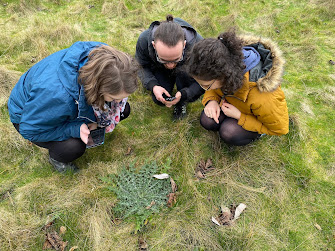Can species reintroductions be successful? The story of the lucky butterflies (part 2: Chequered Skippers)
Chequered Skipper history
The UK's population of Chequered Skipper butterfly (Carterocephalus palaemon) has always been scarce. The only extant native populations are in ten core areas of West Scotland which seem to be stable. The English population, focussed around the East Midlands sadly declined until it went extinct in 1976. However, the Chequered Skipper conservation and reintroduction is another major success story in invertebrate conservation just like the Large Blue reintroduction.
In May 2022, I was lucky enough to visit Fineshade Wood (Northamptonshire) to see the success of the Chequered Skipper reintroduction project. This is the only English population of Chequered Skippers after 40 years of being extinct.
 |
| Chequered Skipper male butterfly (Bob Eade) |
Ecology
The Scottish Chequered Skipper has different ecological requirements, including different caterpillar host plants and habitat types. Scottish specimens are located on open damp grassland, dominated by tall Purple Moor-grass (Molinia caerulea). Whereas, the English butterflies breed in flower-rich woodland rides and glades, dominated by Wood Small-reed (Calamagrostis epigejos) and False-brome (Brachypodium sylvaticum). Former colonies may have used fens or ungrazed calcareous grassland amongst scrub and damp coppiced woodland. The habitat losses caused by declines in coppicing and ride management, and increased conifer plantations resulted in the English population extinction in 1976.
The Chequered Skipper is protected under the Nature Conservation Act in Scotland, a UK BAP Priority Species, and is listed as Endangered on The Butterfly Red List for Great Britain (2010).
Identification
The Chequered Skipper has distinctive chequered upper wing with yellow spots, the underside is similar but has a more muted colouration. This can be seen easily when butterflies bask with their wings open. English adults nectar mostly on Bugle (Ajuga reptans), and also use Ground-ivy (Glechoma hederacea), Bluebell (Hyacinthoides non-scripta), and Marsh Thistle (Cirsium palustre). Males often perch in sheltered positions and dart out to defend their territory from other males or to find a potential mate. They tend to perch next to wood edges or amongst light scrub or bracken. Females tend to fly low among grasses when egg-laying.
There is a single generation per year, with flight season typically between May and late June. More information on how to identify the different life stages can be found on the UK Butterflies website.
Chequered Skipper lifecycle
As with other butterflies and moths, adult female butterflies lay small singular white eggs on specific 'host' or foodplants; the underside of tall grass blades of Wood Small-reed and False-brome in England or Purple Moor-grass in Scotland.
The green caterpillar emerges and forms a protective tube by joining the grass leaf edges together with silk. It feeds outside the tube returning for shelter. Once the grass stem has been eaten the caterpillar moves to a new stem. The caterpillar becomes straw-coloured and overwinters is a grass stem hibernacula. After emerging in April, the caterpillar pupates inside a grass shelter.
Roots of Rockingham Project
The success of reintroduction came once the links between land management and species ecology and genetics was understood. Chequered Skippers from Northern Europe (specifically Belgium) were reintroduced in 2018 to Rockingham Forest after ensuring the right habitat management was in place to allow populations to thrive.
Before reintroductions occurred, The Back from the Brink Roots of Rockingham project restored over 7km of woodland rides and 23ha of vegetation to ideal conditions with wide, flower-filled rides (trackways) and plenty of sunny patches. Once ideal habitat conditions were reached, Belgian adult butterflies were released in 2018. They share a similar habitats and caterpillar foodplants to former English populations.
.jpg) |
| Chequered Skipper on Bugle |
Chequered Skippers Taking Flight
The Chequered Skippers Taking Flight project continued to expand on the initial successes and hopefully populations will become established in additional sites across Rockingham Forest. Continued habitat management is important to ensure the habitat remains in good condition to secure the butterfly's future and that good landscape permeability and site connectivity supports the reintroduced populations.
The project will include work on additional threatened species in this area, including Dingy and Grizzled Skippers, and Adders which benefit from the management work needed for Skipper butterflies. This includes ride widening and management for Chequered Skipper (and other Skippers), scrub removal, bare ground creation, seeding and plug planting for Dingy and Grizzled Skippers, and creation and maintenance of clearings for Adders.
References
Chequered Skipper Butterfly Conservation Leaflet
Jamie Wildman's Thesis on Chequered Skipper ecology, history, and reintroduction
.jpg)


Comments
Post a Comment